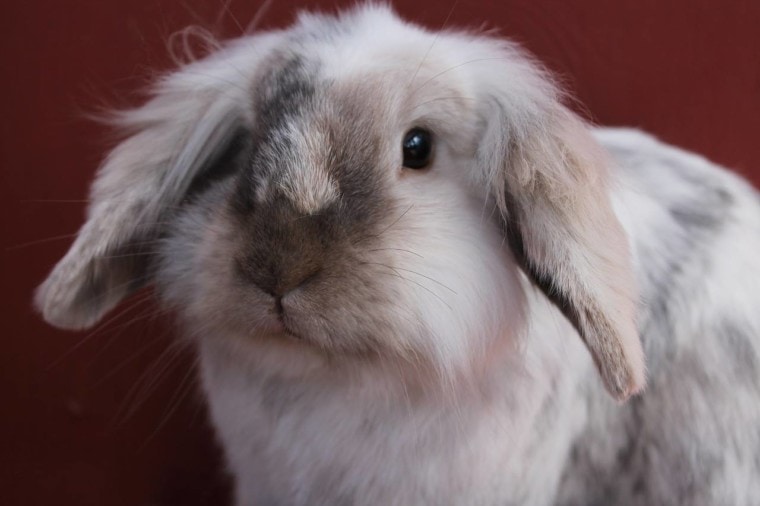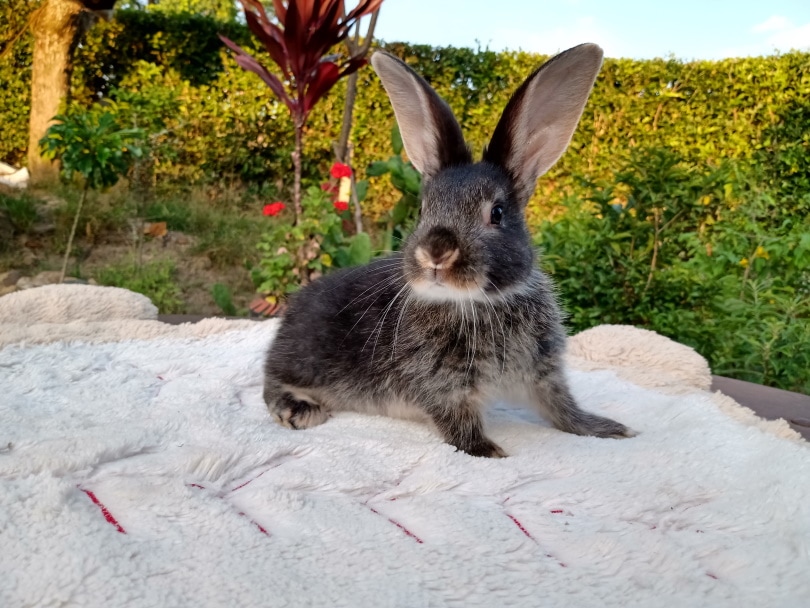
Click to Skip Ahead
Silver rabbits are easy to own and love; they display a people-friendly temperament as delightful as their gorgeous coats. Though rare today, they boast one of the richest histories of any domestic rabbit variety and some of the most desirable character traits. Discover why you should consider this centuries-old breed for your next pet as we discuss the Silver rabbit’s temperament, care needs, and habitat.
Breed Overview
Size:
Compact, medium
Weight:
4.5–6 pounds
Lifespan:
7–10 years
Similar Breeds:
Champagne d’Argent
Suitable for:
Seniors, single owners, families with older children
Temperament:
Friendly, docile, energetic
You can find several unique sides to Silver rabbits from their history to their form. As one of the first breeds to earn American Rabbit Breeders Association recognition, the Silver’s roots date hundreds of years before the organization’s founding. While records place them as far back as the late 1500s in England, the true origins of Silver rabbits remain a point of conjecture.
A handful of rabbits have silver coloration, but Silver rabbits distinguish themselves in their body and coat type. They have a distinct moderate body type not seen in other rabbits and are one of the few breeds judged on the snappiness of their flyback coats.
Silver Rabbit Breed Characteristics
How Much Do These Rabbits Cost?
Despite their relatively long tradition as a domestic breed, Silver rabbit popularity tapered off in the latter half of the twentieth century. Their commercial uses waned, and breedership fell to the point that the Livestock Conservancy gave them a “critical” conservation status. Critical status means fewer than 500 Silver rabbits are likely alive globally and fewer than 50 annual registrations in the country.
The United States and the United Kingdom are the only places to find the Silver rabbit breed. In America, the National Silver Rabbit Club maintains the breeder registry. You can also use the more general Rabbit Breeders Directory to find local rabbitries. A typical Silver rabbit may run roughly $40–$60. As they are a challenge to locate, you can try reaching out to rabbitries in your area for help finding the nearest Silver rabbit breeder.
Temperament & Intelligence of the Silver Rabbit
Silver rabbits are a unique blend of energy and calm. Though docile and relaxed, their compact, muscular frames enable lively personalities. They need a few hours of solid exercise and play but will otherwise be happy to curl up on a lap or hang around the house.
While not commonly considered among the smartest breeds, Silvers are no less intelligent than the average rabbit. With training and consistency, you can housebreak them to a degree. They can learn to use litter boxes and make associations with phrases and tone of voice. From about 6 months, teaching them games and commands can be fun and rewarding for the entire family.

Do These Rabbits Make Good Pets? 👪
All prospective pet parents can find something to like about the Silver rabbit’s adaptable personality. With proper socialization, they can get along with anyone. Children require the same cautious approach you would take when bringing them around other small pets. But as long as they have responsible owners, Silver Rabbits can be a perfect fit. From children to seniors, everybody can enjoy these affectionate, high-spirited rabbits.
Does This Rabbit Get Along With Other Pets?
Perhaps a product of their history of domestication, Silver rabbits are a relatively non-aggressive breed. They will readily get along with most pets if you take the proper steps to socialize them. Ideally, you’ll have a pet that will be safe to have around and can match your Silver’s energy level.
Depending on the breed, cats and dogs will need slow introductions to reduce the chance of predatory behavior. Rabbits and other pets may require several weeks of slow scent exchanges and limited interactions to build the appropriate comfort level. Close supervision will still be essential at all times. Some pets, such as a Savannah cat, will be poor company for your rabbit regardless of how long they live together, so you must carefully consider the household dynamic before bringing a Silver home.

Things to Know When Owning a Silver Rabbit:
A perk of Silver rabbits is that they aren’t a particularly challenging breed to own. Their small bodies are easy for anyone to handle and don’t have extreme dietary needs. They are active, so you need to consider space and entertainment. Otherwise, they’re laid-back and undemanding, a breeze to own for anyone experienced with rabbits, and an absolute joy for all.
Food & Diet Requirements 🥕
Silver rabbits subsist primarily on high-quality hay. Since it’s critical for fiber and teeth maintenance, hay accounts for at least 75% of a Silver’s diet. They will eat a bale roughly their size in one day but should have an unlimited supply.
Silvers generally eat about ¼ cup of pellets daily, with smaller rabbits only needing an ⅛ cup. Two cups of fresh leafy vegetables fill out the rest of their diet. Treats, fruits, and certain non-leafy veggies should only be an infrequent snack throughout the week. Otherwise, ensure your Silver rabbit always has fresh, clean water.
Habitat & Hutch Requirements 🏠
Given their potential for activity, investing in enrichment items in their pen can positively affect a Silver rabbit. Tubes, hides, and toys should be abundant to keep them occupied. Cardboard, paper towel rolls packed with hay, newspaper, and old towels are only a few of the simple, cheap homemade rabbit toys that can entertain your Silver.
Space to move is crucial for an active breed like Silver rabbits. An indoor or enclosed outdoor run is ideal to give them the hours of activity they need daily. They adore attention. If you don’t have other pets to keep up with your Silver rabbit, ensure you give them quality daily interaction to satisfy their need to socialize.

Exercise & Sleeping Needs 🐇
Silver rabbits need at least 3 hours of quality exercise time daily. Giving them a run to enjoy at their leisure is an enormous aid, as they’ll often naturally want to divvy up their active hours. As crepuscular creatures, they generally spend their days sleeping and save their energy for the morning and evening.
Rabbits don’t need anything fancy for bedding, especially if they’re inside. Indoor rabbits can fall asleep on anything soft, whether it’s a bed or a comfy patch of the floor. A dedicated walled-off section for sleeping in an outdoor hutch can make a Silver rabbit feel safe, and soft bedding will provide a cozy, insulated environment.
Training 🥎
Silver rabbits are relatively easy to train. They will learn to use the litter box once you understand their elimination habits and help them build a positive association with using it. You can even teach basic commands to develop good manners and a positive relationship with your Silver. They make it simple with their easygoing nature, but you can ensure trust by staying patient, avoiding aggression, and being consistent.
Grooming ✂️
The Silver rabbit’s dense, short coat allows for fuss-free maintenance. A weekly brushing to remove loose fur is typically all they need, though grooming will pick up during the heavy shedding months. While you brush their hair, checking and addressing debris around the eyes and ears are essential in preventing dangerous infections. Otherwise, scent gland checks, pest inspections, and regular nail clippings will keep your Silver healthy between vet visits.

Lifespan and Health Conditions 🏥
The Silver rabbit doesn’t have an exceptionally long life at roughly 7–10 years. But it’s also not one to have unique health issues. Overgrown teeth and malocclusion are hazardous to any rabbit, including Silver. If your active rabbit spends lots of time in an outdoor run, sanitary issues like flystrike could be a threat. Pests, parasites, and diseases can invade your Silver in numerous ways, but disciplined grooming and frequent vet visits will allow you to prevent and respond to many of the most common issues.
Male vs. Female
Male and female Silver rabbits are virtually identical in looks and size. They have similar temperaments, and despite some cost differences, such as the higher price of spaying a female, there’s almost no contrast in the ownership experience.
3 Little-Known Facts About Silver Rabbit
1. Silvering Distribution is More Important Than the Intensity
A Silver rabbit’s shimmery white guard hairs accentuate the lustrous coat and certainly make it more striking as they fill in. At shows, judges heavily value color, but the degree isn’t the priority. Distribution is more critical than anything, with the best Silvers showing an even spread of the silvery highlights across the back, legs, face, and underside.
2. Silver Rabbits Come in Three Coat Colors, and They Often Shouldn’t Mix
There are three NSRC-recognized Silver rabbit colors: black, brown, and fawn. The brown coloration is a unique label, as many breeds use alternative terms, such as chocolate. While the Si gene determines the silvering phenotype, the various color and dilution genes that come before it define the Silver’s base color.
Not all colors have received the same considerations in terms of breeding, making it risky to cross different-colored Silvers. For instance, years of breeding for a particular color may have culled out specific genes in one color line but not another. By introducing those undesirable genes, you could get a coat with smut and other imperfections. There is also a broader concern that unknown genetics could lead to unexpected and unrecognized tones in subsequent generations.

3. Silver Rabbits Are Born Solid-Colored
Like many rabbits, the Silver rabbit’s fur changes color as it ages. When they’re born, there’s little to no indication of any silvering in their single-colored coats. Silvering generally fills in without uniformity. In rabbits with prominent silvering changes, such as the Champagne d’Argent, the coat can take on an almost piebald pattern for the first few months of life.
Final Thoughts
Silver rabbits are a challenge to find, even in the two countries the breed lives. It’s unfortunate from a pet ownership perspective because there are few faults to overcome. They’re not typically hostile or domineering over other pets and maintain calm demeanors amid adversity. Grooming is easy, as is general upkeep and handling, thanks to their small frames. Give them room to flourish, and they’ll surprise you with their boundless affection, energy, and zest for life.
Featured Image Credit: Pixabay








